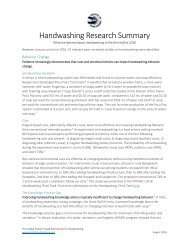WASH’ Nutrition
manuel_wash_nutrition_online
manuel_wash_nutrition_online
Create successful ePaper yourself
Turn your PDF publications into a flip-book with our unique Google optimized e-Paper software.
LEARN<br />
MORE<br />
A follow-up document to the Bonn WASH <strong>Nutrition</strong> Forum 2015:<br />
http://us4.campaign-archive2.com/?u=bc3ae3e573afc6e78bf46bfd1&id=6cb40c5326&e=b36d315897<br />
For more about Generation <strong>Nutrition</strong>: www.generation-nutrition.org<br />
Sanitation and nutrition “Let’s break the vicious circle” video: www.youtube.com/watch?v=yWIr-eJ8FAs<br />
WASH and nutrition factsheet:<br />
http://www.generation-nutrition.org/sites/default/files/editorial/generation_nutrition_factsheet_no._1_wash.pdf<br />
For more information on No Wasted Lives: http://www.nowastedlives.org/<br />
BOX 21: Missing Ingredients Report – WaterAid and SHARE Consortium<br />
‘The Missing Ingredients’ report by WaterAid and SHARE analysed 13 countries to understand the degree to which nutrition<br />
and WASH are coordinated and integrated into respective national plans and policies. On the basis of the results of this<br />
research, and supplemented by existing evidence and experience, five key findings emerge from the research:<br />
1 WASH into nutrition varies widely. All nutrition plans and policies analysed recognise the importance of WASH;<br />
however, the degree to which WASH is embedded within plans in terms of objectives, targets, interventions and<br />
indicators varies significantly across countries.<br />
2 <strong>Nutrition</strong> into WASH is limited. Very few WASH plans reference nutrition or identify opportunities to integrate with<br />
nutrition and health programmes and campaigns. The exception was Liberia.<br />
3 One size doesn’t fit all. There is no single blueprint for how WASH should be embedded in nutrition plans, nor for<br />
how WASH programmes can be made more nutrition-sensitive. However, consideration of some key principles<br />
and approaches could help drive progress. For example, designing WASH programmes to target populations most<br />
vulnerable to nutrition and/or identifying opportunities to integrate activities such as those related to behaviours<br />
such as personal and food hygiene and breastfeeding could result in more joined-up approaches.<br />
4 Continuum approach. Working together should be considered along a continuum, with different degrees or<br />
approaches to collaboration. At the lower end this may simply involve sharing of information, while at the other end<br />
of the spectrum this can look more like an integrated programme.<br />
5 Policies and plans alone are not enough. The success of programmes will require more than just a good plan.<br />
Integrated plans must be supported by sufficient financing, effective coordination, timely tracking of results, and<br />
stronger institutional processes and mechanisms to support cross-ministerial work.<br />
National nutrition plans<br />
How well are water, sanitation and hygiene integrated?<br />
Kenya<br />
Nepal<br />
Sanitation Stunting<br />
Water<br />
Sanitation<br />
46 %<br />
Stunting Water<br />
37 % 92 %<br />
Bangladesh<br />
Liberia<br />
30 %<br />
26 %<br />
63 %<br />
Sierra Leone<br />
Sanitation Stunting<br />
Water<br />
Uganda<br />
Sanitation<br />
61 %<br />
Stunting Water<br />
36 % 87 %<br />
17 %<br />
32 %<br />
76 %<br />
Sanitation Stunting<br />
Water<br />
Sanitation<br />
13 %<br />
Stunting Water<br />
38 % 63 %<br />
19 %<br />
34 %<br />
79 %<br />
Tanzania<br />
Timor-Leste<br />
Rwanda<br />
Sanitation<br />
16 %<br />
Stunting Water<br />
35 % 56 %<br />
Sanitation<br />
41 %<br />
Stunting Water<br />
52 % 72 %<br />
Key<br />
Zambia<br />
Sanitation<br />
62 %<br />
Stunting Water<br />
38 % 76 %<br />
Madagascar<br />
WASH in background<br />
analysis<br />
All three components of<br />
WASH included<br />
WASH objective included<br />
Sanitation<br />
44 %<br />
Stunting Water<br />
40 % 65 %<br />
Malawi<br />
Sanitation<br />
12 %<br />
Stunting Water<br />
49 % 52 %<br />
WASH activities included<br />
WASH roles and<br />
responsibilities defined<br />
Sanitation<br />
41 %<br />
Stunting Water<br />
42 % 90 %<br />
Mozambique<br />
Statistics<br />
% of population with 'improved' sanitation<br />
% of children under five stunted<br />
% of population with 'improved' water<br />
Comprehensive WASH<br />
interventions<br />
WASH targets and<br />
indicators included<br />
Budget for WASH activities<br />
Sanitation<br />
21 %<br />
Stunting Water<br />
43 % 51 %<br />
Well<br />
integrated<br />
Performance rating<br />
Partial<br />
Needs<br />
improving<br />
Unknown<br />
WASH ministry involved<br />
in planning<br />
Structures, coordinating<br />
mechanisms and/or<br />
review groups include<br />
WASH ministry<br />
Stunting % source: Global database on child growth and malnutrition, joint child malnutrition estimates – levels and trends (2015 edition), UNICEF-WHO-The World Bank Group.<br />
Timor-Leste: G-RDTL 2013, Timor-Leste Food and <strong>Nutrition</strong> Survey 2013. Dili: MoH.<br />
Stunting definition: Moderate and severe: percentage of children aged 0-59 months who are below minus two standard deviations from median height-for-age of the WHO Child Growth Standards.<br />
Sanitation and water % source: WASHWatch (accessed 15/04/16), which uses WHO/UNICEF Joint Monitoring Programme for Water Supply and Sanitation – 2015 data.<br />
<strong>WASH’</strong><strong>Nutrition</strong><br />
A practical guidebook<br />
135



